When
I moved into this house over 13 years ago, the front yard was a dark, dank,
shabby place. It was lower than the road
and fully shaded. The first 20 feet or
so was often bare damp dirt with scraggly weeds, the roadside ditch was unkempt
and the trees were dying. Things
improved when Tim removed 150 trees from the side yard making way for his
garage and parking area. The sun dried
things out, we covered the ditch and planted a good lawn. But the dying trees along with scraggly
patches of tiger lilies and elderberry bushes remained.
 |
We began cleaning up the area on a snowy winter's day.
One tree down six more to go |
We've spent a lot of time, sweat and money making the back and side lawn areas nice. This was the year to finally address the front yard. First we cut out the trees that we felt comfortable removing ourselves, then hired a tree service to remove the ones that threatened the power lines. We also had all the stumps ground out and temporarily repaired the lawn.
 |
| A tree dangling from the crane is set down in an open area instead of being felled. |
The tree service came in with a large crane, tied off to the top of the trees and picked each one up and set it in the parking area where they could safely lay them down and section them out. It was a busy day, and it was also the day that Tim tore his rotator cuff and long head tendon in his left shoulder. The surgery and recovery set our summer projects back a couple of months.
 |
| The stump grinding left Tim with large piles of chips to haul away and compost. |
We had the tree service leave the stumps that were in the
area of the water curb box and gas hookup.
These would be removed when the water was connected.
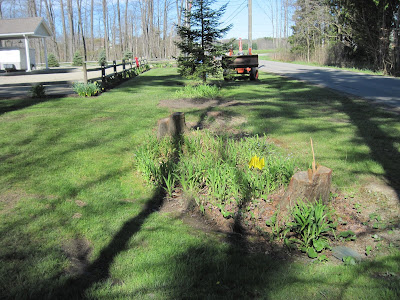 |
| Our raggedy front entrance with stumps and tiger lilies |
The next big project was the city water hook up. We have a good well, and have never made use
of our city curb box. Tim and our friend
the excavator ran the water line up the middle of the driveway (Tim finds
gravel much easier to repair than lawn).
Our well remains functional and will be run into the new garage for
washing cars and watering landscaping.
We now have two sources of water available. Well, three if you count the rain collection system.
 |
| The water line runs down the middle of the driveway towards the road |
When that was all cleaned up our frontage was left looking
very barren. There is a catch basin
which takes the water off the front lawn and directs it into the covered
“ditch” along the road. The house sits
several feet higher than the road but the catch basin, although only about 12
feet off the road edge, is several feet below road grade.
 |
| This may look flat but it's not |
This results in a very low front yard which deceptively appears “flat” and in particular, a contoured area around the catch basin which would be impossible to mow with a riding mower. The amount of fill that it would require to raise the entire front lawn so that the runoff would reach the road (and the resulting lawn installation) was daunting.
So Tim came up with an idea.
He comes up with all our landscaping ideas. I just try to keep up and make it look pretty
in the end. His idea was to turn the
impossible low spot into a “dry creek bed”.
Hereafter referred to as “The Big Drain”.
We always stockpile materials. You never know when you are going to need
some rock. In this case we needed a lot
of flat rock. And we had a lot of flat
rock left over from the construction of (and recently recovered from the
removal of) a nice little frog pond over at the house next door. I remember the summer Tim collected all those
flat rocks hauling them by the trailer load from a nearby creek bed. Every Saturday he would “go rocking”. It seemed to take all summer.
The first two days involved Tim cutting back
the bank that is up against the road and our driveway and using the flat stones
to build a semi-circular retaining wall.
He wanted to make it look sort of like a little stone bridge. And he laid flat stones all around the drain
cover with a large flat rock set above the drain with a gap all around to let
the water run underneath it.
At this point I began to wonder what the neighbors think as
they watch this stage by stage construction. I wonder what they think we're up to? I am sure that even after they watch the progression from cutting trees
in the winter to the final mulching and grass seeding in the summer, that they
forget what it used to look like and do not appreciate the work that goes into
these projects. I know we forget. That’s why we are always referring back to
old photos and the progression photos trying to figure out if we’ve made a
difference or not.
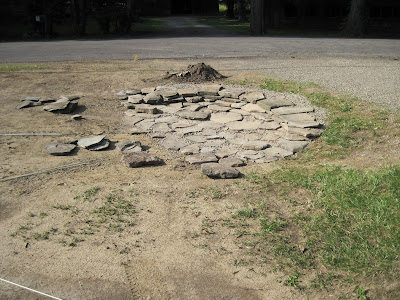 |
A light rain left the run off areas visible in the dirt.
We marked them so we could follow them as we built |
That weekend Tim and I spent the Friday laying more flat
stones and referring to Internet photos of other folk’s dry creek bed projects
for inspiration. We knew we needed round
rocks and some sizable “boulder” sized rocks. We were all out of those, so we hooked up the trailer and headed to Dad’s creek. When we got the load home, we threw them off
into categories. Baseball rocks, basketball
rocks, beach ball rocks and character rocks.
It looked like we had scattered our toys all over the front yard. I’m sure the neighbors were thinking “Now
what?”
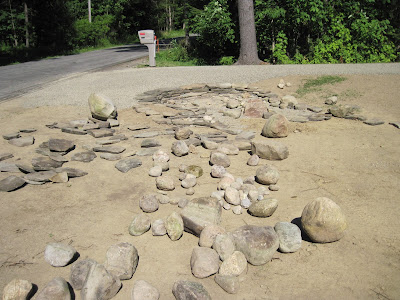
Each rock had to be dug into the slope so it would sit level with the rocks around it and form a gradual run off. We didn't want it to look like a flagstone patio so we tried to add larger stones here and there and we scattered all sizes of washed stones in the bed itself. The ground was like concrete and required a mattock to loosen it to any depth. We would find two rocks that fit together like a puzzle and then after we got the ground beneath it prepared, we would have a hard time figuring out how it fit the first time. Tim likened it to putting together a jigsaw puzzle with no picture on it. The weather that weekend was in the low nineties but we still had a lot of fun digging in the dirt, and we were pretty pleased with how it turned out.
 |
Having the creek bed carved out of the slope gives a better
perspective as to how not-flat the lawn really is there. |
 |
| Spending time in Dad's creek gave us a good idea of how a natural creek arranges the rocks. We placed larger rocks for interest and then grouped smaller rocks and gravel where material would slow down and settle. |
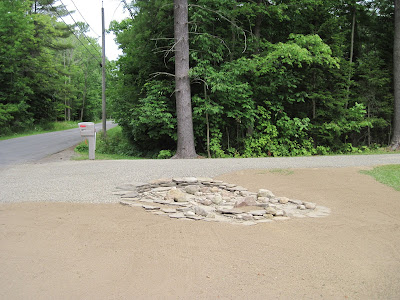 |
We incorporated a couple of planting areas with the
intention of planting some grasses on the edge.
|
We had some rain prior to this which had eroded the bare dirt around The Big Drain so we were able to mark these drainage areas and try to direct the water flow into the drain from two directions. This also showed us where we were going to have to dam up our landscaping to direct water around it. The neighbors began to slow down, roll down their car windows, and offer encouragement. Overall, the reviews were positive. We spent the rest of Saturday and most of Sunday laying our dry creek bed around The Big Drain. And on Monday it rained.

It rained a lot. It rained an inch and a half in under an hour. Our dry creek bed was no longer dry. In fact, it was a pond. Tim stood out in the rain under an umbrella to see what would happen and where the water would run. When the rain washed all of the grass clippings out of the lawn and clogged the catch basin he had to get a pry bar from the garage and remove the cover stone entirely allowing the "pond" to drain. And I’m sure you can guess that the rain also washed a lot of dirt into our pristine rocks. A lot of dirt. I removed five gallons with a trowel.
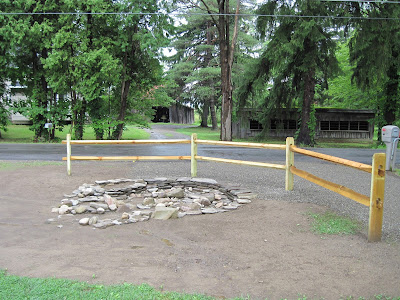
Step three was a split rail fence. When Tim built the retaining wall he graveled
up to it effectively widening our driveway entrance by over a foot and a half
which only encouraged the mail man to cut the corner and Tim was sure it was
only a matter of time until he (or someone else) landed in The Big Drain. So we put in three sections of split rail
fence, finishing up just as another gully washer hit washing all the dirt I’d just removed back into the stones.
Step four was landscaping.
I wanted a grassy look and something that would provide some color. I bought some grasses and day lilies. We had recycled Siberian irises and
myrtle sort of lying around that would fit into the plan pretty well. We've moved towards using a lot of ground cover in our landscape beds with the intent of mulching and edging less. We like something thick that we can mow right up to. We have a lot of myrtle available here and it grows well, but with it's low growth habit it can be hard to keep out of the lawn.
The ground surrounding the drain was very hard and gravely so I had to dig ample
holes and fill in with good compost and slow release fertilizer.
The side against the road we mulched with gravel, a continuation of the driveway. Our friend Sandy who owns a landscaping
business will be so pleased. She’s been
trying to get Tim to mulch with gravel for awhile now. She seems to think that will cut down on
weeds. I know for a fact that weeds grow
just as well in gravel as they do in mulch so we’ll see. On the lawn side we needed a substantially raised planting area to direct the water from the lawn around to the mouth of the drain. That side is mulched with shredded bark mulch.

The
next morning Tim woke up determined to replace the recycled myrtle with something more interesting. So off we went to the nursery to look at
other ground covers. I had put some
Chameleon plants in the gravel corner against the road and Tim really liked them. So we came home with three and a
half flats of “aggressively invasive” Chameleon plants (and some weeds). Well I’ve never met a useful ground cover
which was not aggressive and/or invasive.
The one thing I do not like in a ground cover are those which migrate to
greener pastures leaving their original planting space unattended. The Chameleons can’t get into too much
trouble being bordered
on two sides by rock and the other side by a lawn mower. I will have to defend my day lilies for a few
years until they get established.
The Chameleon plants should add some color and I think they make the lawn side of the arrangement look like a wet creek area.
We planted grass seed and washed all of the unwanted dirt into the basin where we could collect it and clean it out. We tried to plan it so we would have at least 4 days with no rain to give the quick grow seeds a chance to sprout before they had to face a gully washer. But as soon as we finished, the weather forecast changed from 6 days with no rain to 2 days with no rain. So Tim got out his upholstery kit and sewed two burlap bolsters which we filled with gravel and placed across each opening to try to slow the dirt and seeds washing back into the creek bed.
 |
| Hopefully these burlap sacks will hold the grass seed back from planting itself in our rocks. |
We admired our handy work for a few hours. This project started in winter and finally finished months later in the heat of the summer. We didn't have a finished goal in mind. Like most of our projects, it evolved over time.
And then Tim turned around to the other side of the driveway opening and said... "Now what are we going to do over here?"



